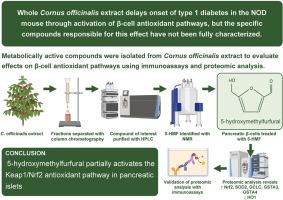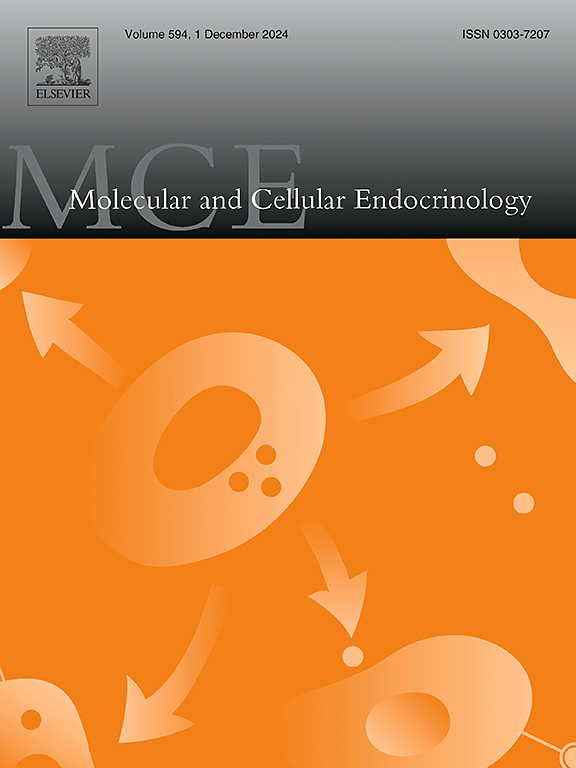NMR and proteomic analysis of Cornus officinalis extract reveals abundance of 5-hydroxymethylfurfural and induced expression of Nrf2 and superoxide dismutase-2 in 1.1B4 human pancreatic β-cells and murine islets
IF 3.6
3区 医学
Q2 CELL BIOLOGY
引用次数: 0
Abstract
We aimed to identify and isolate the metabolically active compounds from Cornus officinalis (C. officinalis) that underlie the biological effects previously observed in our in vitro and in vivo studies. Our prior findings demonstrated that C. officinalis promoted activation of the Keap1/Nrf2 pathway in a pancreatic β-cell line and delayed the onset of type 1 diabetes (T1D) in non-obese diabetic (NOD) mice. To characterize the metabolically active compounds within C. officinalis, the concentrated extract was fractionated by column chromatography, and evaluated for their effect on β-cell metabolic activity and expression of Nrf2 targets such as heme oxygenase-1 (HO1) and superoxide dismutase 2 (SOD2). Highly concentrated compounds of interest within metabolically active fractions were isolated using high performance liquid chromatography (HPLC). Elucidation of a highly abundant compound within C. officinalis extract was identified by mass spectrometry and nuclear magnetic resonance (NMR) as 5-hydroxymethylfurfural (5-HMF) which was demonstrated by immunoblotting to significantly increase SOD2 expression. Quantitative proteomics was performed on 5-HMF treated murine non-obese diabetic (NOD) islets and revealed increased expression of Nrf2 and downstream targets such as SOD2, GSTA3, GSTA4 and GCLC. Our findings suggest that 5-HMF is a highly abundant and metabolically active compound within C. officinalis that stimulates partial activation of the Keap1/Nrf2 pathway.

山茱萸提取物的核磁共振和蛋白质组学分析显示,5-羟甲基糠醛在1.1B4人胰腺β-细胞和小鼠胰岛中丰富,并诱导Nrf2和超氧化物歧化酶-2的表达
我们的目的是鉴定和分离山茱萸(C. officinalis)中代谢活性化合物,这些化合物是我们之前在体外和体内研究中观察到的生物学效应的基础。我们之前的研究结果表明,officinalis促进了胰腺β细胞系中Keap1/Nrf2通路的激活,并延缓了非肥胖糖尿病(NOD)小鼠1型糖尿病(T1D)的发病。为了表征officinalis中代谢活性化合物的特征,采用柱层析法对其浓缩提取物进行了分离,并评估了其对β细胞代谢活性和Nrf2靶蛋白如血红素氧化酶-1 (HO1)和超氧化物歧化酶2 (SOD2)表达的影响。利用高效液相色谱法(HPLC)分离出代谢活性组分中的高浓度化合物。通过质谱分析和核磁共振(NMR)鉴定,山茱萸提取物中富集的一种化合物为5-羟甲基糠醛(5-HMF),免疫印迹法证实该化合物可显著提高SOD2的表达。对5-HMF处理的小鼠非肥胖糖尿病(NOD)胰岛进行定量蛋白质组学分析,发现Nrf2和下游靶点如SOD2、GSTA3、GSTA4和GCLC的表达增加。我们的研究结果表明,5-HMF是一种富含代谢活性的化合物,可以刺激Keap1/Nrf2通路的部分激活。
本文章由计算机程序翻译,如有差异,请以英文原文为准。
求助全文
约1分钟内获得全文
求助全文
来源期刊

Molecular and Cellular Endocrinology
医学-内分泌学与代谢
CiteScore
9.00
自引率
2.40%
发文量
174
审稿时长
42 days
期刊介绍:
Molecular and Cellular Endocrinology was established in 1974 to meet the demand for integrated publication on all aspects related to the genetic and biochemical effects, synthesis and secretions of extracellular signals (hormones, neurotransmitters, etc.) and to the understanding of cellular regulatory mechanisms involved in hormonal control.
 求助内容:
求助内容: 应助结果提醒方式:
应助结果提醒方式:


